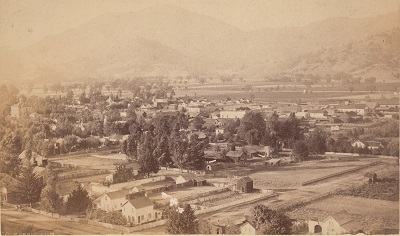Ask A Librarian, Calistoga
History of Calistoga
What can you tell me about the history of Calistoga?
“Calistoga is located in the northern part of the Napa Valley, which is framed on its east and west sides, respectively, by the Howell and Mayacamas Mountain ridges. The Napa River and its tributaries drain the Napa Valley, and Calistoga lies in the uppermost portion of the valley…The area within city limits covers approximately 2.5 square miles. Most of the land within city limits is located on the Napa Valley floor, which is punctuated by small hills, including Mount Washington and Mount Lincoln. The western city limits extend into the foothills of the Mayacamas Mountains, and the eastern edge abuts the dramatic Palisades, which lie at the foot of nearby Mount St. Helena…In addition to the dramatic visual setting provided by nearby hills and mountain ridges, local geology provides Calistoga with unique geothermal resources including its famed hot-springs. Local volcanic and alluvial soils also combine to provide the basis of the city’s abundant and longstanding agricultural tradition.”[1]
The Wappo lived around present-day Calistoga between 500 and 5,000 years, and called the land Nilektsonoma, or “Chicken Hawk Place,” and Tu La Halusi, “a beautiful land.”[2] Padre José Altimura, the founder of Mission San Francisco Solano in Sonoma, arrived in the Napa Valley in 1823. He named the region Agua Caliente, or “hot water,” in reference to the hot springs that would later play an important role in Calistoga’s evolution. After Mexican independence and the secularization of the missions, the Mexican government began giving away large swaths of land to prominent citizens. Dr. Edward Turner Bale settled on land encompassing Calistoga when he was granted the nearly 18,000 acre Rancho Carne Humana in 1841 after marrying into the prominent Vallejo family and built grist and lumber mills.
“The scenery in the vicinity of Calistoga is the most picturesque and grand of any in Napa Valley. Here the mountains on either hand, timbered with groves of oak and pine, or green with chaparral, become more bold and broken; those on the north being faced with long, rocky terraces and crowned with cliffs and crags. Making up their sides are many wild glens, dark with vines and shrubbery.”[3] Samuel Brannan’s hot springs resort helped put the sleepy little farming community on the map. Author Robert Louis Stevenson also helped popularize Calistoga. He and his new bride Fanny Vandegrift honeymooned in a cabin near the abandoned Silverado Mine, and he later wrote the popular book Silverado Squatters. Calistoga grew slowly, but soon after the resort appeared, so too did a business district alongside Lincoln Avenue (now Foothill Boulevard). Homes were built along Washington Street, and the railroad connected the upper valley to Napa and Vallejo.
Calistoga was incorporated as a town in 1876, and reincorporated as a city in 1886. During World War II, “Calistoga was a seasonal resort town, with plenty of soda fountains, restaurants, and bars (word was that Calistoga had the most bars per capita in the state). The town was surrounded mostly by prune and walnut orchards and dairies. There were only four wineries in the area ([in 2012]: forty-six). The walnut plant on Washington Street was a major job source in the fall. There were two chicken hatcheries just outside of town, and several families raised rabbits for sale as food.”[4] Prior to World WarII, the population of Calistoga was less than 1,000, but by the 1970s there were nearly 4,000 residents; today, just over 5,000 people live in the Calistoga city limits.[5] The town has steadfastly retained its 19th century air by banning fast food franchises and maintaining a walkable downtown area. Its biggest business is tourism connected with the hot springs and wineries.
[1] City of Calistoga. (2003). 2003 General Plan. Retrieved from http://www.ci.calistoga.ca.us.
[2] Waters Jr., J. (2008). Calistoga. San Francisco: Arcadia Publishing.
[3] Smith & Elliott (Eds.) (1878). Illustrations of Napa County, California with Historical Sketch. Oakland: Smith & Elliott.
[4] Rannells, J. (2012). Calistoga 1944: A small town during a big war. Calistoga, Calif.: Jack Rannells.
[5] Ibid.


